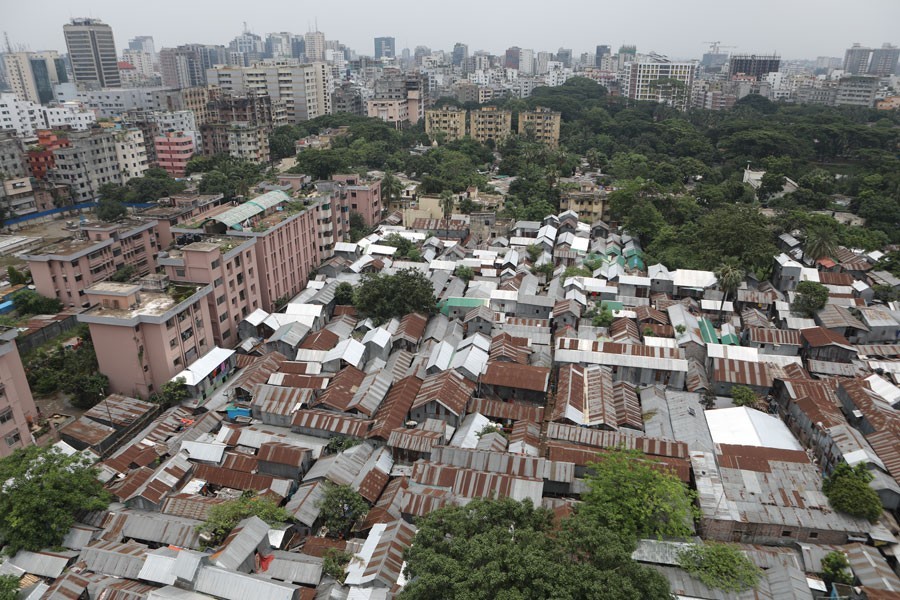In any welfare state, or a semblance of it, the spectacle of 6/7-storey residential structures made of corrugated iron will be considered outright atrocious. To the people having the minimum sympathy or compassion for humanity are expected to stand against the authorities who allow these harbingers of injuries and deaths. Ironically, the two tin-shed multi-storey slums standing haughtily in two parts of the capital do not arouse any emotional surge or sympathy for the people residing there for years. What's surprising, the city people in general would have remained in the dark about these structures harbouring seeds of mishap, had not news about them been published in a handful of dailies.
In other countries, such terrible residential facilities would have kicked up storms of protests and the demand that they be abolished without further delay. In spite of the photographed news stories in the major print media outlets, 'apartment owners' continue renting out rooms and floors nonchalantly in the structures. They have little compunction that electrification or fire accidents may occur there any time. It's because all kinds of utility connections to the structures are unlawful.
The lower oncome people renting living spaces in these high-rises are apparently lured by the urge to live like the well-off segments of society. They are least bothered about the life-threatening hazards in the midst of which they have to live with their families. Few have the time to alert them to the multi-faceted dangers lurking everywhere in such tin-made high-rise dwellings. Apart from the poverty-stricken families, their tenants range from street hawkers, canvassers of myriad commodities, cheats and pickpockets, prostitutes and their agents posing as married couples --- and the omnipresent drug addicts and drug pushers. At times muggers find these apartments quite safe for using them as hideouts. On being chased by police, they take shelter in one of the rooms, ferreting out the suspected criminals from where turns out to be a daunting task.
Notwithstanding Dhaka's notoriety for its large slums or shanties for decades, the trend of switching over to constructing multi-storey tin-made structures is a recent phenomenon. Although many legal or illegal owners of these apartments were initially doubtful about their ability to draw tenants to their all-facility 'colonies', their ventures finally proved a great success. As they discovered, there were no dearth of tenants willing to live in these dwellings --- fabulously taller than the traditional slums in terms of status. The ground-level slums normally stand for all kinds of filth and disease-spreading pests. They include the dysentery germs including common flies, pathogens of various communicable and fatal fevers. The multi-storey slums are viewed as free of diseases thanks to their location above the ground. Outwardly, it seems effusive of disease-free life and health. In fact it is not.
These tin-made high-rises present a look of being free of infectious diseases. The endless supply of piped water; and the seemingly infinite electricity and gas make these ideal abodes. But when it comes to the perennial hazards encircling the people living there, few places could be more unlivable. A cataclysmic disaster may befall the people there anytime. The largely improvised structures having utility supplies cannot ensure a safe life. Just over a year ago, a similar structure tilted to its side in the capital's northern neighourhood. However, the extent of casualty was less than feared. But few can say it will pass off without hazards if it occurs again.
Although the capital doesn't have many multi-storey slums, many so-called 'real estate'-hopefuls are allegedly engaged in parleys with influential quarters in order to see their dream come true. Amid these activities, a high-rise 'bastee' in the Postogola area continues to thrive. According to its residents, the facilities here are more than that hit by a collapse disaster in Dhaka's northern part. The Dhaka citizens in general appear to be unaware of these high-rise slums. Had they been in the know of the developments, they would have called seminars, symposiums etc to discuss the pros and cons of the trend of setting up high-rise corrugated iron slums.
The slum-centred activists, too, wouldn't have been silent. They would, in all likelihood, take the case of the high-rise slum dwellers' safety. In the meantime, the authorities concerned ought to have intervened with their decision whether they would allow the construction of these multi-storey tin slums. Apart from the many hazards facing the dwellers of these unusual residential facilities, the tin-made high-rises are also an eyesore. On the other hand, these slums are highly vulnerable to fire incidents. Moreover, it has to be assured if these dwellings meet the requirements of the country's housing policy. As stop-gap solution, the authorities concerned may go for constructing tin-roofed barracks on the city outskirts. This project can be followed later by the fully concrete multi-storey colonies like those made for different lower-class communities. The capital's ultra poor fully deserve to be the residents of the multi-storey concrete high-rises.
shihabskr@ymail.com


